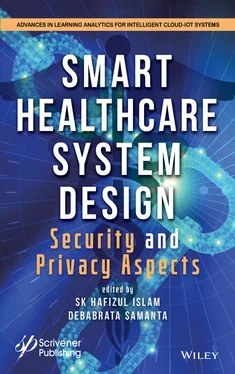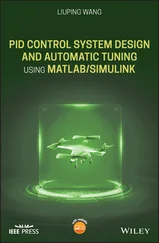36. Kumari, N.P. and Yadav, V., Heart Rate Monitoring and Data Transmission via Bluetooth. Int. J. Innovative Emerging Res. Eng. , 2, 2, 1–6, 2015.
37. Lambat, M.M. and Wagaj, S.C., Health Monitoring system. Int. J. Sci. Res. , 4, 247–250, 2015.
38. WahyuKusuma, R., Ridha, I., Rianto, Y., Swelandiah, E.P., FPGA based heartbeats monitor with fingertip optical sensor. IJCSEIT , vol. 4, no.5, October 2014.
39. Gayathri, S., Rajkumar, N., Vinothkumar, V., Human health monitoring system using wearable sensors. Int. J. Innovative Res. Comput. Commun. Eng. , 4, 4, 12–15, April 2016.
40. Samanta, D., Shivamurthaiah, M.P., Kumar, K., Umesh, D., Siddalingappa, K., Wireless Sensor Networks model for monitoring system based on IoT. Solid State Technol.
41. Neshenko, N., Bou-Harb, E., Crichigno, J., Kaddoum, G., Ghani, N., Demystifying IoT Security: An Exhaustive Survey on IoT Vulnerabilities and a First Empirical Look on Internet-Scale IoT Exploitations. IEEE
Communications Surveys & Tutorials , vol. 21, no.3, pp. 2702–2733, third quarter 2019.
42. Ferreira, A.G. et al. , A smart wearable system for sudden infant death syndrome monitoring. Proc. IEEE Int. Conf. Ind. Technol. (ICIT) , pp. 1920–1925, 2016.
43. Bisio, I., Delfino, A., Lavagetto, F., and Sciarrone, A., Enabling IoT for in-home rehabilitation: Accelerometer signals classification methods for activity and movement recognition. IEEE Internet Things J. , 4, 1, 135–146, Feb. 2017.
44. Stanislav, M. and Beardsley, T., Hacking IoT: A Case Study on Baby Monitor Exposures and Vulnerabilities , Boston, MA, USA, 2015.
45. Gubbi, J., Buyya, R., Marusic, S., Palaniswami, M., Internet of Things (IoT): A vision architectural elements and future directions. Future Gener. Comput. Syst. , 29, 7, 1645–1660, 2013.
46. Meneghello, F., Calore, M., Zucchetto, D., Polese, M., Zanella, A., IoT: Internet of Threats? A Survey of Practical Security Vulnerabilities in Real IoT Devices. IEEE Internet Things J. , 6, 5, 8182–8201, Oct. 2019.
47. Massad, M.A. and Alsaify, Baha’, A., MQTTSec Based on Context-Aware Cryptographic Selection Algorithm (CASA) for Resource-Constrained IoT Devices. Information and Communication Systems (ICICS) 2020 11th International Conference on , pp. 349–354, 2020.
48. Xing, L., Reliability in Internet of Things: Current Status and Future Perspectives. Internet Things J. IEEE , 7, 8, 6704–6721, 2020.
49. Chinchero, H.F., Marcos Alonso, J., Hugo Ortiz, T., LED lighting systems for smart buildings: A review. Smart Cities IET , 2, 3, 126–134, 2020.
50. Dammak, M., Aroua, S., Senouci, S.M., Ghamri-Doudane, Y., Suciu, G., Sachian, M.-A., Roscaneanu, R., Ozkan, I., Gungor, M.O., A Secure and Interoperable Platform for Privacy Protection in the Smart Hotel Context. Information Infrastructure and Networking Symposium (GIIS) 2020 Global , pp. 1–6, 2020.
51. Frustaci, M., Pace, P., Aloi, G., Fortino, G., Evaluating Critical Security Issues of the IoT World: Present and Future Challenges. IEEE Internet Things J. , 5, 4, 2483–2495, Aug. 2018.
52. Halloush, R.D., Transmission Early-Stopping Scheme for Anti-Jamming Over Delay-Sensitive IoT Applications. Internet Things J. IEEE , 6, 5, 7891–7906, 2019.
53. Kirupakar, J. and Mercy Shalinie, S., Situation Aware Intrusion Detection System Design for Industrial IoT Gateways. Computational Intelligence in Data Science (ICCIDS) 2019 International Conference on , pp. 1–6, 2019.
54. Alasmary, H., Khormali, A., Anwar, A., Park, J., Choi, J., Abusnaina, A., Awad, A., Nyang, D., Mohaisen, A., Analyzing and Detecting Emerging Internet of Things Malware: A Graph-Based Approach. Internet Things J. IEEE , 6, 5, 8977–8988, 2019.
55. He, Y., Tang, L., Ren, Y., Maximizing Sleeping Capacity Based on QoS Provision for Information-Centric Internet of Things. Access IEEE , 7, 111084–111094, 2019.
56. Rattanalerdnusorn, E., Thaenkaew, P., Vorakulpipat, C., Security Implementation For Authentication In Iot Environments. Computer and Communication Systems (ICCCS) 2019 IEEE 4th International Conference on , pp. 678–681, 2019.
57. Gupta, U., Tripathi, Y., Bhardwaj, H., Goel, S., Kaur, A., Kumar, P., Energy-Efficient Model for Deployment of Sensor Nodes in IoT based System. Contemporary Computing (IC3) 2019 Twelfth International Conference on , pp. 1–5, 2019.
58. Kokila, J., Ramasubramanian, N., Naganathan, N., Resource Efficient Metering Scheme for Protecting SoC FPGA Device and IPs in IoT Applications. Very Large Scale Integration (VLSI) Systems IEEE Transactions on , vol. 27, no. 10, pp. 2284–2295, 2019.
59. Mcginthy, J.M. and Michaels, A.J., Secure Industrial Internet of Things Critical Infrastructure Node Design. Internet Things J. IEEE , 6, 5, 8021–8037, 2019.
1 *Corresponding author: karthi.karthis@gmail.com
2
Smart Health Application for Remote Tracking of Ambulatory Patients
Shariq Aziz Butt1*, Muhammad Waqas Anjum2, Syed Areeb Hassan3, Arindam Garai4 and Edeh Michael Onyema5
1 The University of Lahore, Lahore, Pakistan
2NCBA&E, Lahore, Pakistan
3 The Superior University, Lahore, Pakistan
4 Dept. of Mathematics, Sonarpur Mahavidyalaya, Kolkata, India
5 Dept. of Mathematics and Computer Science, Coal City University, Enugu, Nigeria
Abstract
The Internet of Things (IoT) has amalgam with many fields. One of these is the eHealth monitoring of patients. mHealth monitoring is the most prominent subdomain of eHealth. In mHealth, IoT enables the merging of various devices, including wearables (watch and sensors) and holding (smart mobile phone) devices. Therefore, the application development of mHealth is a penetrated domain in the research community. Different research work exists to develop mHealth applications to monitor different diseases either remotely or physically. Mostly the mHealth applications work with the context of the patient that includes the type of disease and observing the environment. The development of these applications faces several issues, such as security, smartness, decision making, size of the application, and timely actions. This study presents the issue with the health sector and with fuzzy logic while using for health enhancements. Moreover, this work highlights key factors to be addressed in mHealth such as mobilityawareness, location-based medication, and the security of eHealth’s data, distance, and measurement. These all features are very imperative for the health application to improve wellness.
Keywords :Smart health, mobility of patient, remote monitoring, fuzzy concepts for health
Due to the growing of the Internet of Things (IoT), it has created revolutionary inventions and modifications in the health section. It makes healthy smart health in terms of eHealth and mHealth. Due to the technological encroachments the health professional adopts the technology very vastly for monitoring and improve the patients’ health. The internet technology made the patient’s life very easy to monitor and treat. In mHealth and eHealth, IoT enables the merging of various devices, including wearables (watch and sensors) and holding (smart mobile phone) devices. Therefore, the application development of mHealth is a penetrated domain in the research community. Technology also improves health for special kinds of patients who are known as ambulatory patients. These patients need monitoring at their location remotely. It becomes possible with the mHealth application that supports the medical professionals to monitor, treat patients, and send the medication in the case of any abnormality occurrence. It helps the patients to receive tele-medication services from doctors at their location in case of any emergency. But on the other hand instead of all these facilities and supports of internet technology to the health domain still many challenges need to be addressed to enhance the health sector. These challenges include the Emergency Support, Issue with the Chronic Disease Monitoring, Issue with the Tele-Medication, Issue with the Tele-Medication, Mobility of Doctor, Data Storage Issue, Application User Interface issue, and Security Threats. In this chapter, we discuss the health sector, improvements in health, issues with the health domain, and fuzzy-based security solutions to overcome the security issues.
Читать дальше












